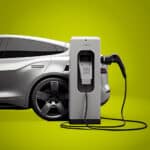Just Northeast of San Diego, California, Cajon Valley Union School District boasts an impressive track record for school sustainability. The home of the Braves already powers 26 of their school campuses with solar, introducing over 16,000 students to clean energy in the classroom. Now, three schools (and counting) have electric vehicle charging stations, all warehouse vehicles are being replaced with electric trucks, and the school bus fleet contains 5 electric school buses, with plans underway to triple their electric bus fleet. They even are part of their local utility’s pilot vehicle-to-grid (V2G) program, enabling bus batteries to bolster grid reliability by returning electricity to the grid during times of high energy demand.
We were lucky to connect with Juan Noriega, a school bus driver who was at the frontline of the district’s transition from diesel to electric school buses. His passion for electric buses is infectious, so much so that we’re considering getting our school bus driver’s license so we can experience it for ourselves. Here is that interview, edited for length and clarity. Enjoy!

Generation180: What were your initial thoughts about electric school buses?
Juan Noriega: The personal vehicle that I drive is a Prius, so I had experience with efficient cars, but never with electric vehicles. I was excited, but very worried about how long the batteries would last. That was my main concern, because if the battery was to run out, I would be concerned about the wellbeing of the students. Otherwise, I didn’t foresee any problems.
Generation180: What adaptations did you have to make to drive electric?
Juan Noriega: The transition was not that difficult at all and not extreme, like I thought it would be. Once you’re actually driving, you don’t focus on the specifics of the bus. You just switch from considering mpg to kw/h. The electric buses are very well manufactured, drive smoothly, and perform well.
As long as you drive carefully, like you’re supposed to for the kids (i.e. you can’t speed, can’t stop or accelerate too quickly), you are maximizing the performance of the bus and that lends itself to maintaining the electric battery. Acceleration was great, stopping was the same, and going uphill is a bit different.
I really enjoy driving electric buses. It’s something different, something new. The kids that get to ride in them are the “select few” since only 5 buses in our fleet out of 40 are electric; so they feel different and special.
Generation180: Is there anything you missed about diesel buses after making the switch?
Juan Noriega: I don’t miss having to fill them up! It’s wonderful not having to visit the diesel pump every day and have to inhale those fumes. As long as you plug them in at the yard, you’re set. It’s super easy, plus mess-free and smell-free.
So, I don’t miss anything really about diesel buses since electric buses handle everything as well, and more. While there are some routes we can’t use the electric buses on because they don’t have the range for it (we have 100 mile range buses), overall, they serve our needs. As long as we plan ahead, as the fleet operations team does, it’s not an issue.
Generation180: What do you like most about the buses: smooth to drive, acceleration, safety, noise?
Juan Noriega: Quietness. Definitely. With that said, we do have a small noise it makes on purpose for 0-15 mph so people know we’re there. It’s a fun jingle, so everyone jokes that the electric school buses are like an ice cream truck.
The noise factor makes a big difference. Diesel is just so loud, and starting up close to a neighborhood at 5:30 am with 40 buses turning on would negatively impact the community. Now we have fewer community concerns and complaints, as electric buses make no sound to start.
Plus, the AC works really well.
Generation180: What did parents and students say – did they like them?
Juan Noriega: The buses look different (yellow and blue, not yellow and black, for fire safety reasons), so everyone knows who rides on the electric buses. Kids these days are very used to screens, so since the dashboard is a screen, they easily relate to the control panel and often ask questions. All of the kids are excited by them, whether they ride them or not. When dropping kids off, parents and students alike often remark “woah, it’s electric! I’m curious, can I look inside?” The community accepted and welcomed the buses, wanting to learn more about electric transportation.
I also drove a lot of students with learning disabilities, and a major benefit for the majority of students was the lack of noise from the diesel engine. Plus, in the long-term, it’s improving their health by cleaning up the air they breathe every day.
Generation180: Do you have any advice for bus drivers that might be wary about giving up a vehicle they are comfortable with for an electric model?
Juan Noriega: Take the plunge! It’s a very easy vehicle to drive. It is basically the same in terms of drivability, so you’ll slip right in. You have to be aware of what you’re doing and your basic principles are the same. You just have a different motor and you have a different range.
I work for dispatch now and plan the routes, so it’s not on the driver. We manage the routes and range of the buses, and we would not send them on long routes or field trips they can’t handle. Technology is improving, as are bus charge points. For now we have limitations, and we use fleet management to address them.
It’s a matter of having an open mind and trying it, so get behind the electric wheel!
***
Interested in bringing solar, electric school buses, or other clean energy technologies to your school? Explore our resources and answers to common questions at our Help Desk and get started!















